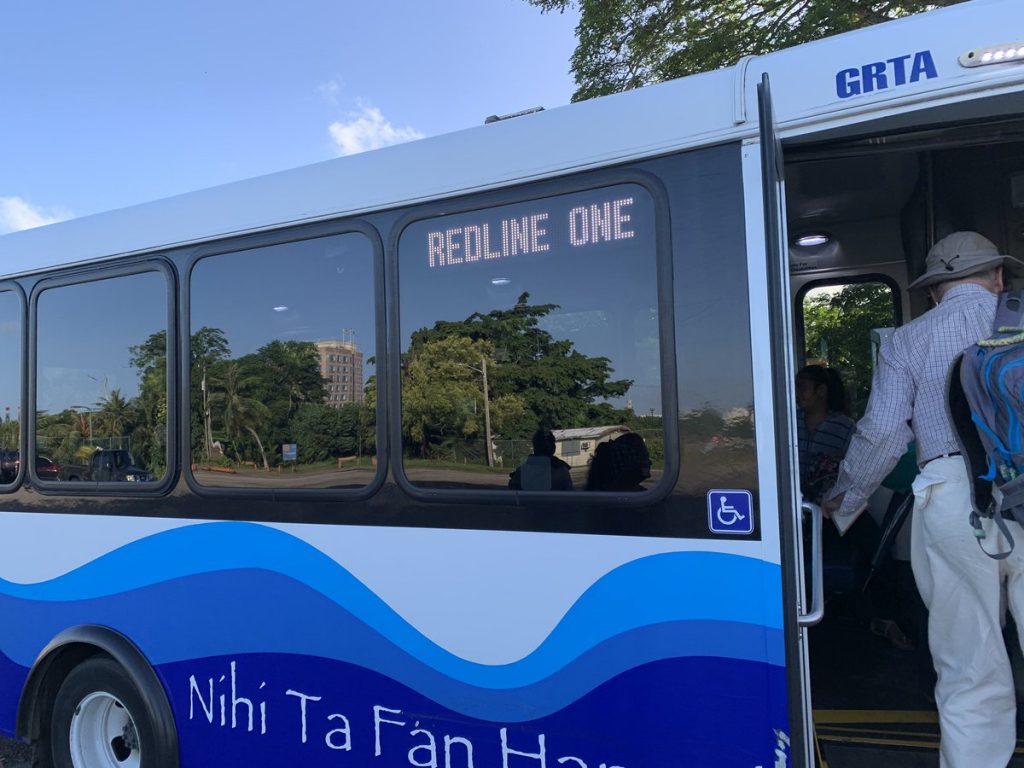#MassTransit Social Experiment. #Guam has one of the highest motor vehicles per capita. To live in a cleaner future, mass transit needs to be reliable and our default.
— Kyle Dahilig #ClimateStrike (@dahiligkyle) December 1, 2019
I will be documenting my ride to @UOGTriton, and I hope that this will spark meaningful action.#ClimateAction pic.twitter.com/9C9CNpJxnE
written on 2 dec, 2019.
I walked out my house at 6:01.
The sun wasn’t awake yet, but I decided to leave early to be sure that I had a seat on the first ride. Thankfully, it wasn’t rainy. Had it been, I know my umbrella wouldn’t have been enough to keep me dry.
Pacewalking from my house to my first bus stop took me 15 minutes, and when I had arrived, I was sweaty, partly from my pace and the other part was my worry that I had missed the bus. But then, I met Kai. You wouldn’t have known that you have reached the bus stop at first glance because there is no sign or physical bus stop.
I asked her about the transit experience and this is what she shared with me:
I use it [mass transit] to work every day. Sometimes the bus comes by 6:15, but if you miss the first one, you can catch the second one at 7:50. If the bus is full, you can’t stand anymore. You’d need to wait for the other bus.
Kai
She told me that in order for me to have the all-day pass, I would have needed to purchase it at ITC building. Had I purchased one, I would’ve saved 50¢ (next time, I thought).
The first bus was late- arrived at 6:31. I checked my schedule and figured I missed my connection.
When we arrived, my connecting bus was still there, but I was two people too late for a seat on the bus.
To make time pass, I striked up another conversation, this time with John. We shared an interesting conversation.
“I used to work in the food industry, but I want to do something else. I went to high school in the states, but my family wanted me to come home. I am going to apply for a job.”
John
Before my next connection, I talked with other daily mass transit commuters. I was offered a rosary at one point. Then, I met Louise. She was one of the commuters who missed the connecting bus to Hagatña and had contacted the driver for the second trip.
Thanks to her, I was able to ride on the four passenger van to Hagatna (there were still more commuters). We talked about family and personal challenges (really nice to listen to others). This ride took about 40 minutes, but it felt less.
When we arrived in Hagatña, Louise and I talked more. She said that she was on her way to visit family down south. I told her why I was riding mass transit today, and she helped me figure out what lines I would ride.
My last ride arrived around 8:10. It was only then did I come up with the idea of using mass transit to go ‘around the island’ with friends- $4 all day anywhere around the island is rather cheap (buy the all day pass).
The following is a collection of shared, paraphrased sentiments among daily mass transit commuters and drivers.
“The old bus schedule was better. For 20 years, we’ve had the same route. Then, you get someone [current administration], to change it up. The mainland assessed us, and we aren’t doing good.”
People don’t ride transit because it is unreliable and inconsistent.
Shared collection of opinions from daily bus drivers and commuters
“When it rains, most stops are unreliable at protecting us. Sometimes we go to the nearest building and when the bus comes, it leaves because it doesn’t see us.”
“Before we had one bus that took us places, one fee. Now, the buses are smaller and the rides are expensive.”
I arrived at UOG at 9:00. My commute was 2.5 hours. I have learned more about Guam’s mass transportation system than any story I’ve heard, article I’ve read and website I’ve surfed. You listen to real people and stories (as well as new smells). I encourage everyone to step out of their comfort zone and ride mass transit. Because it is an experience you can only encounter- not read about.
And if we want to live in a future with clean air, water and soil, public transportation would need to be our default. 1) Educate the public about mass transit, 2) Mitigate carbon emissions and 3) Adapt by using mass transit.
